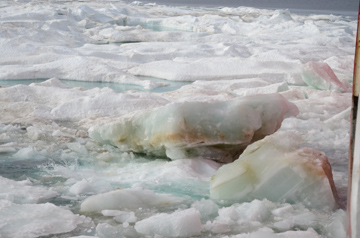270712 arctic bloom.JPG

Phytoplankton may be common beneath some polar ice caps. Credit. Dr. Ken Dunton, University of Texas Marine Science Institute
The underside of a polar ice cap doesn’t sound like a very inviting abode for life. But a recent study found massive amounts of microscopic life beneath the Arctic ice — as much as scientists have seen anywhere in the entire oceans.
During the summer of 2011, scientists used an icebreaker to plow far into the ice sheets of the Chukchi Sea, which is on the southern edge of the Arctic Ocean between Alaska and Siberia. When they sampled the water beneath the ice, they were in for a surprise. Waters below the ice caps are usually relatively devoid of the microscopic plant-like organisms known as phytoplankton. But these waters were packed full of phytoplankton, from the surface down to depths of more than 150 feet.
The difference may be sunlight. Most ice caps are fairly thick and are covered with snow, so almost no light passes through them. Like plants on land, phytoplankton use sunlight as an energy source, so they can’t grow in the dark.
But this ice was young and thin. And as the ice warmed in spring, some of the snow atop it melted, forming patches of clear ice that let the Sun shine through. The combination of sunlight and nutrients dredged up by springtime currents allowed the phytoplankton to grow like crazy.
Researchers aren’t sure how much phytoplankton is growing under other parts of the polar ice cap. But if it’s anything close to what they saw in the Chukchi Sea, there could be far more of it in Arctic waters than anyone had guessed — growing in the most unexpected of places.

